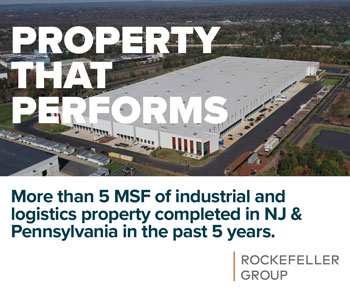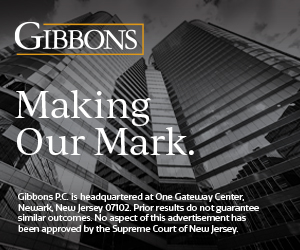From left: Andrea Hsu of NK Architects, Jennifer Ellis-Rosa of Gensler, Shuli Sadé of Sadé Studio and Shane Connell of the Connell Co. took part in a Feb. 27 panel discussion hosted by Morris Arts. — All images courtesy: Morris Arts
By Marlaina Cockcroft
The panelists at this year’s Morris Arts Commercial Real Estate Breakfast had plenty of wisdom to share about using art and design in spaces to make people healthier and happier.
As Andrea Hsu, principal and interior designer at Morristown’s NK Architects, described it, art “brings together the identity of a space, where people feel more connected to their space and therefore more connected to what’s happening in their space and those human connections that are forming.”
The annual event explores how art is integrated in commercial development projects. This year’s breakfast, held Feb. 27, was titled Wellness by Design: Connecting Art, Health and Real Estate Development. It was hosted by the Bayer Corp. at its North American headquarters in the Whippany section of Hanover and presented by Morris Arts, the nonprofit that enjoys broad support from commercial real estate leaders in the region.
“Morris Arts has always believed in the power of the arts to bring people together,” said Conor Evans, founder and managing partner of Community Builders, who serves as a Morris Arts board member and cochairs the event. “We know that the arts don’t just decorate a community. They help define it.”
Frank Vitolo, a Morris Arts board member and moderator of the panel, addressed the current state of the commercial real estate market, with offices downsizing and corporate campuses struggling. But there’s a flight to quality in Class A office space, he said, citing Sanofi’s 260,000-square-foot headquarters in Morristown as an example. The Sills Cummis & Gross PC attorney also expects the return-to-office movement to spread and said Morris County has many suburban office parks that need to be reimagined.

In those cases, if you’re not taking advantage of spaces for wellness and congregating, Vitolo said, “you’re missing the boat.”
Shane Connell, executive vice president of The Connell Co., detailed the art and wellness elements of the firm’s wide-ranging redevelopment known as The Park at Berkeley Heights. The mixed-use project, which includes adding apartments, shops and restaurants to the existing 185-acre office park off Interstate 78, will feature more than 10 acres of public space.
It’s also using the arts in “transforming what the spaces feel like,” putting works including a Warhol on display, and “using art as a way to extend” The Park’s master brand of “live your life,” Connell said. As for wellness, The Park features natural light in shared spaces and chefs working with local farms. Game rooms, pool tables, red light therapy, nap rooms and gyms help maintain a work-life balance, as do scheduled events like wine tastings.
Mixed media artist Shuli Sadé, whose studio is in Jersey City, said her large-scale public artworks featuring local landmarks encourage community in a variety of settings, including health care. For instance, “Aqua Data,” a piece with blue wave imagery, was installed in 2016 at the former Partners HealthCare in Somerville, Massachusetts, and later moved to Massachusetts General Hospital. Thousands of people walk by the work every morning, Sadé said, and “it gives me such a great pleasure to know that it’s a respite for the people who are going upstairs.”
Her art isn’t just soothing — it ensures people don’t get lost. “Urban Renewal,” installed in 2023 at Montefiore Einstein Advanced Care in Manhattan’s Hudson Yards neighborhood, uses bright primary colors to direct people. That can mean blue artwork that guides them to the blue room, Sadé said, citing the importance of art in health care facilities “because it’s so confusing, especially in hospitals.”

Jennifer Ellis-Rosa, a workplace strategist at Gensler, said she thinks about wellness in terms of accommodating all the users of a space. She’s passionate about the topic because her college roommate had muscular dystrophy, “and I had to watch her experience the world and the different experiences that she had to overcome.”
From the beginning of a project, she said, different types of users need to be involved to help inform the design. For instance, the Morristown coffee shop known as Ethan & the Bean, which employs people with autism and intellectual disabilities, was designed to be welcoming to the employees and to the community. The wide space between tables “was extremely intentional” to accommodate people in wheelchairs or who were training or using guide dogs, since The Seeing Eye guide dog school is nearby. The point is for “anybody to be able to traverse the space easily.”
Including nature in a space can also help people’s wellbeing. Ellis-Rosa said Gensler recently designed a project with a plant wall that was “not only beautiful to look at, but it actually helped air quality in the space.” And spaces without heavily patterned flooring or unnecessary level changes are easier for some users to navigate.
“There’s really a plethora of options that could be explored,” she said.
NK Architects’ Hsu closed the panel with her thoughts on art in health care spaces. She said interior design is not just about creating beautiful spaces but “how we can impact outcomes in those spaces,” like shortening distances so nurses can spend more time with a patient.
The firm uses evidence-based design, which relies on data and empirical research to show how design can improve health. For instance, Hsu said, the Journal of the American Medical Association found that exposing patients to nature-based artwork led to a 30 percent reduction in their anxiety levels.
Those principles came into play for the new eating disorder unit at Robert Wood Johnson University Hospital Somerset in Somerville. Hsu said the team used a nature theme throughout, relying on natural light and highlighting a circle motif as “a symbol of wholeness and unity.” The lighting is dimmable to match patients’ circadian rhythms.
The pediatric day department at Morristown Medical Center uses colorful wall coverings as “distraction graphics” while a child is being examined. In the behavioral health unit, a child can use a remote to change the color of the room, taking some control over their space, Hsu said.
The point, according to the panelists, is to design with a larger goal in mind.
“How do we create spaces that actually help people to heal?” Hsu asked. “And in those same spaces, how do we make it better for people to work in them?”
Marlaina Cockcroft is a freelance writer based in New Jersey.









